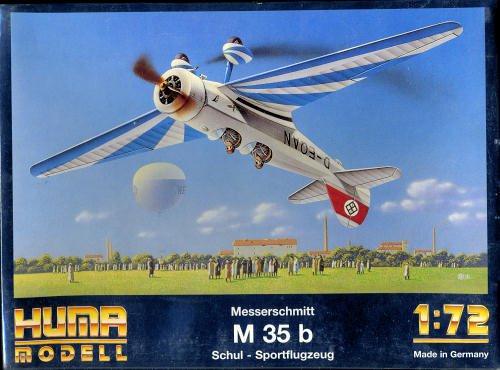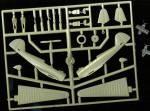
Huma 1/72 Messereschmitt M-35
| KIT #: | 2000 |
| PRICE: | $8.95 at the LHS |
| DECALS: | One option |
| REVIEWER: | Scott Van Aken |
| NOTES: | This may well be Huma's first kit. |

| HISTORY |
Over the period 1927-33 Messerschmitt designed a series of six sports plane planes, the single seat M.17 and M.19, and the two-seat M.23, M.27 M.31 and finally the M.35. With the exception of the M.23, none sold in large numbers. They were all single-engine low-wing cantilever monoplanes with open cockpits and fixed undercarriage. The M.35 kept the extended fuselage of the M.27 and combined it with an undercarriage of single leg, spatted form.
Two different engines were used. The M35a had a 112 kW (150 hp), seven-cylinder radial Siemens Sh 14a and the M.35b a 100 kW (135 hp) four-cylinder inline inverted air cooled Argus As 8b. The former was the shorter and faster of the two. The aircraft first flew in 1933.
The aircraft was first shown to the public and potential buyers at the 1934 Aerosalon in Geneva. In that year, Rudolph Hess won the Zugspitz trophy in a M.35. In 1934-1935, Will Stor won the German Aerobatic Championship in a M.35a, and in 1935 the women's prize was taken by Vera von Bissing in a similar machine.
Despite these successes and strong performances at other venues in the late 1930s, only 15 M.35s were built, 13 registered in Germany, one in Spain and reputedly one in Romania. Though the M.35a was faster, the M.35b was the more common; only two M.35as are definitely identified.
| THE KIT |
 Something
not often kitted are light aircraft and even less frequently, those of the
1930s. Huma, a company well known in modeling circles for doing the more unusual
aircraft and sticking with things German, kitted the M-35 and it was probably
their first model. Typical of short run kits, the parts are a tad on the side of
the less refined. I found ejector pin marks in all sorts of places, like the
front edge of the seats, back of the instrument panels, and on the inside of the
one-piece wheels/spats. On the other are sink areas.
Something
not often kitted are light aircraft and even less frequently, those of the
1930s. Huma, a company well known in modeling circles for doing the more unusual
aircraft and sticking with things German, kitted the M-35 and it was probably
their first model. Typical of short run kits, the parts are a tad on the side of
the less refined. I found ejector pin marks in all sorts of places, like the
front edge of the seats, back of the instrument panels, and on the inside of the
one-piece wheels/spats. On the other are sink areas.
Thankfully, there are none of these on the wings and tailplanes, though they do have a rather pronounced 'hills and valleys' effect. There is also some flash on parts, the greatest amount on the engine cowling. This may well be due to the number of pressings of this kit over the years. There is no interior detailing aside from two blank instrument panels. The two crew are to be glued in their seats and this covers up the lack of additional detail. Probably the trickiest part of the build will be getting the gear legs properly attached to the spats. The rest of it is pretty simple, though detaching the tiny windscreens from their massive sprues may well require patience and care.
 Instructions
are a single piece of folded paper. On one side in what looks like something
done on a typewriter, is a history of the type (in German), parts layout and
seven construction drawings. On the back is the painting and markings diagram in
what looks like 1/72 scale. This plane is basically while with large, blue
sunburst on the upper wings and a large blue center fuselage and wing section.
The markings are for Will Stor's championship plane. Interestingly, swastikas
are included as are several spares. These are to be placed in a white circle on
a red tail band. The decals are well printed and very glossy.
Instructions
are a single piece of folded paper. On one side in what looks like something
done on a typewriter, is a history of the type (in German), parts layout and
seven construction drawings. On the back is the painting and markings diagram in
what looks like 1/72 scale. This plane is basically while with large, blue
sunburst on the upper wings and a large blue center fuselage and wing section.
The markings are for Will Stor's championship plane. Interestingly, swastikas
are included as are several spares. These are to be placed in a white circle on
a red tail band. The decals are well printed and very glossy.
| CONCLUSIONS |
Perhaps not everyone's cup of tea, but if you are into light aircraft, planes of the 30's or aerobatic subjects, then this is one you really should seek out.
| REFERENCES |
November 2009
If you would like your product reviewed fairly and quickly, please contact me or see other details in the Note to Contributors.